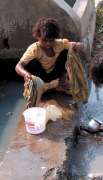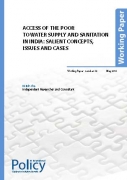/topics/contamination-pollution-and-quality
Contamination, Pollution and Quality
Mitigating climate change through organic agriculture - Keynote address at the Third Organic Farming Association of India Convention, held at Anand, Gujarat (2010)
Posted on 25 Dec, 2010 10:43 PMGreen Revolution (GR) technologies, supported by official policies, and fuelled by agro-chemicals, machinery and irrigation, are well known to have improved agricultural production and productivity. While these technologies greatly helped developing countries to address their food-security and food-sovereignty needs, farmers using these technologies have had to depend on external inputs.
Cancun: Is it a climate meet with a difference?
Posted on 25 Dec, 2010 07:58 PMDespite the pre-Cancun Wikileaks revelation of U.S. strong-arm tactics at the Copenhagen summit, and U.S. climate envoy Todd Stern's remarks about "climate bribery", wherein he said countries asking for aid were in no position to accuse the U.S. of bribery; it is largely perceived that the Cancun Climate Meet has picked up the lost momentum of Copenhagen.
193 nations met at Cancun to debate on how to move forward on the climate change adaptation process and drafted the Cancun Agreement.
Saving rice - Ambitious plans to increase productivity
Posted on 24 Dec, 2010 10:13 AMEnormous funds are being poured into research aimed at improving seed varieties, with a heavy focus on developing hybrid rice. Is it the right option for millions of small rice farmers who are already battling high input costs and increasingly unpredictable weather? Or does part of the solution lie in efficient methods of cultivation that will cut down water use and improve yield?
The economic impacts of inadequate sanitation in India: Rs. 2.4 Trillion equivalent of 6.4 per cent of GDP – A report by WSP
Posted on 24 Dec, 2010 09:27 AM This study report by the Water and Sanitation Programme (WSP), a global partnership administered by the World Bank suggests that inadequate sanitation causes India considerable economic losses, equivalent to 6.4 per cent of India's GDP in 2006 at Rs. 2.4 Trillion. It analyzed the evidence on the adverse economic impacts of inadequate sanitation, which include costs associated with death and disease, accessing and treating water, and losses in education, productivity, time, and tourism. The findings are based on 2006 figures, although a similar magnitude of losses is likely in later years.
This study report by the Water and Sanitation Programme (WSP), a global partnership administered by the World Bank suggests that inadequate sanitation causes India considerable economic losses, equivalent to 6.4 per cent of India's GDP in 2006 at Rs. 2.4 Trillion. It analyzed the evidence on the adverse economic impacts of inadequate sanitation, which include costs associated with death and disease, accessing and treating water, and losses in education, productivity, time, and tourism. The findings are based on 2006 figures, although a similar magnitude of losses is likely in later years.
The study focused on the safe management of human excreta and associated hygiene behavior. The methodology adopted by the study included disaggregating the economic impacts of inadequate sanitation into health-related impacts including premature deaths, costs of treating diseases, and productive time lost due to illnesses; domestic water-related impacts including household treatment of water, and money and time costs to obtain safe water; welfare losses including additional time spent by people for accessing toilets or open defecation sites, and girls having to miss school, and women not going to work; and the loss of potential tourism owing to inadequate sanitation.
Data on incidence (e.g. diarrheal diseases, deaths, etc.) were compiled from national sources (National Family Health Survey, WHO Demographic and Health Surveys, and other Govt. of India sources). Based on scientific literature, attribution factors were used to estimate the populations impacted by inadequate sanitation. Economic valuation was carried out using costs/prices based on secondary studies.
Umiam Lake and Shillong's Rivers: In spite of the odds – An advocacy flyer by Arghyam and Peoples Learning Centre
Posted on 22 Dec, 2010 11:01 PM This advocacy flyer by Arghyam and Peoples Learning Centre (PLC) Shillong highlights some of the main problems, action underway and potential solutions to cleaning up the water bodies of Shillong. It deals with the expanding human habitats and escalating socio-economic activities around the rivers Umkrah and Umshyrpi that flow through Shillong leading to their choking with sewage and pollution. This wastewater eventually enters Lake Umiam, which is a reservoir for hydro-electric power.
This advocacy flyer by Arghyam and Peoples Learning Centre (PLC) Shillong highlights some of the main problems, action underway and potential solutions to cleaning up the water bodies of Shillong. It deals with the expanding human habitats and escalating socio-economic activities around the rivers Umkrah and Umshyrpi that flow through Shillong leading to their choking with sewage and pollution. This wastewater eventually enters Lake Umiam, which is a reservoir for hydro-electric power.
PLC is a non-profit organisation that works towards promoting knowledge on equity and rights, and is a platform for facilitating interdisciplinary dialogues between stakeholders in key developmental issues. Arghyam supports PLC in engaging with decision makes as well as citizens in order to create public opinion about river and lake pollution, and promote catchment friendly practices.
Effluent treatment facilities across Golden Corridor does not conform to GPCB norms – A press release by Paryavaran Suraksha Samiti
Posted on 20 Dec, 2010 10:39 PMContent Courtesy: Radical Socialist
Author: Paryavaran Suraksha Samiti
In this press release dated 4th June 2010, the Paryavaran Suraksha Samiti expresses concern that the effluent treatment facilities across the Golden Corridor do not conform to the Gujarat State Pollution Control Board (GPCB) and demands that effluent discharge at Tadgam Sarigam Pipeline, from FETP, Ankleshwar, ECP, Vadodara and CETPs of Ahmedabad be stopped.
Access of the poor to water supply and sanitation in India - Salient concepts, issues and cases by the International Policy Centre for Inclusive Growth
Posted on 20 Dec, 2010 10:04 PM This paper by the International Policy Centre for Inclusive Growth deals with access of the poor to water supply and sanitation in India. It argues that economic, technical, institutional as well as social factors constrain access to safe drinking water and proper sanitation in India for both the urban and rural poor, and that coverage figures do not reflect this restricted access. It finds that, increasingly, communities are being required to manage their own water and sanitation schemes, not just in rural areas but in urban ones as well.
This paper by the International Policy Centre for Inclusive Growth deals with access of the poor to water supply and sanitation in India. It argues that economic, technical, institutional as well as social factors constrain access to safe drinking water and proper sanitation in India for both the urban and rural poor, and that coverage figures do not reflect this restricted access. It finds that, increasingly, communities are being required to manage their own water and sanitation schemes, not just in rural areas but in urban ones as well.
The paper deals with domestic water supply and sanitation and presents a historical overview of the phenomenon in rural and urban India. This is followed by a critique of available figures for coverage which, it is contended, seem exaggerated because they do not account for the several constraints to access. It addresses the specific institutional problems faced in the public sector delivery of these two utilities in India apart from dealing with the parallel yet thus far limited presence of the private sector in these twin arenas.
Mining - An increasing threat to our rivers - Article by Nitya Jacob
Posted on 20 Dec, 2010 12:29 AMContent Courtesy: Solution Exchange and Nitya Jacob
Author: Nitya Jacob
India’s arteries are choking. Her rivers, the lifeline of hundreds of millions, are over-taxed, polluted and encroached. They are being mined, dammed and emptied of water. Save for the four monsoon months, most rivers are streams of drains, depending on how many cities they pass through. This year people gaped in awe at the River Yamuna (I am sure they were over-awed by other rivers elsewhere too) as for the first time since 1978 looked like a river and not a drain.
Transdisciplinary method for water pollution and human health research – A working paper by Peter Mollinga
Posted on 19 Dec, 2010 06:21 PMThis paper discusses how to go about designing an interdisciplinary or transdisciplinary research project or programme, with ZEF’s research initiative on ‘water pollution and human health’ in India as the background of the presentation. A summary is given of Pohl and Hirsch Hadorn’s main arguments regarding ‘design principles’ for inter- and transdisciplinary research, and the basic tools they have developed for this are discussed in the context of ZEF’s ‘water pollution and human health’ research initiative.
Mine the gap: Connecting water risks and disclosure in the mining sector – A report by the World Resources Institute
Posted on 17 Dec, 2010 10:43 PMThis paper by the World Resources Institute outlines potential water-related risks facing the mining industry and highlights important gaps in water-related disclosure. The purpose is to provide information, questions, and tools to help the financial community better evaluate water-related risks facing mining companies.





